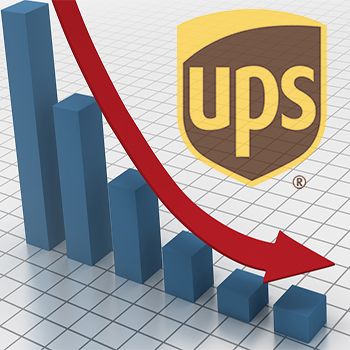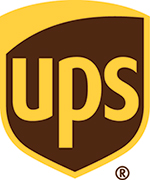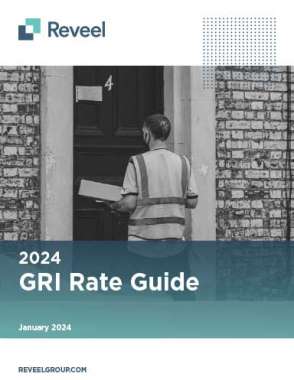UPS Reports Surprise Drop in Revenue

Sales hurt by lower fuel-surcharge rates; profit jumps on overseas business.
UPS reported today that third quarter revenue was down 0.4 percent annually at $14.2 billion, due to currency exchange rates and lower fuel surcharges.
But earnings per share at $1.39 was up 5.3 percent, ahead of Wall Street estimates of $1.37.
Earnings per share (EPS) has now grown for three straight months for the Atlanta-based company, with CEO David Abney saying that these quarterly results reflect strong progress on the company’s long-term initiatives despite what he called uneven economic conditions.
“During the third quarter, our International segment again produced double-digit growth in operating profits, and the U.S. Domestic and Supply Chain and Freight units performed as planned,” he said.
“We remain on track to achieve the higher end of our full-year earnings guidance (of $5.37). U.S. GDP growth has remained relatively unchanged. E-commerce has continued to expand, but the strong dollar has contributed to lower industrial production growth and softer exports”
UPS also addressed Peak Season on the call, with Abney noting the company has a multifaceted strategy for implementing selective pricing initiatives and adding new capacity that is aligned with customer needs and installing innovative technology solutions. And he added that UPS is working closely with customers to ensure it has the operating plans in place that will provide excellent service at an appropriate cost.
UPS Executive Vice President and Alan Gershenhorn said on the call that the growth in online shopping and returns continues to redefine Peak Season at UPS, explaining that during the period between Peak Season and New Year’s UPS expects to complete about ten percent more deliveries compared to the same period last year.

“On our planned peak day of December 22, we are scheduled to deliver about 36 million packages worldwide, which is more than twice a typical day,” he said. “Looking at the market, the National Retail Federation expects holiday retail sales (which it defines as the months of November and December) by 3.7 percent, and online sales are expected to rise between 6 and 8 percent. We have broadened our strategy for Peak this year and these actions are producing year-round benefits.”
The executive cited three areas in which UPS is focusing on to improve customer experience and also financial results, including: collaborating with customers to align UPS capacity with their needs; installing world-class technology solutions; and implementing selective pricing initiatives.
In the third quarter, UPS delivered 1.1 billion packages for a 1.9 percent annual increase and driven by gains in U.S. air products and European transborder shipments.
Consolidated revenue per piece at $10.48 was down 2.2 percent, with U.S. domestic packages and international package averages at $9.37 (down 0.3 percent) and $16.67 (down 7.3 percent), respectively.
U.S. domestic package revenue was up 1.9 percent at $8.86 billion, and average daily package volume up 0.6 percent at 14.55 million, which was due to Deferred Air and UPS Next Day Air up 13 percent and 4 percent, respectively, with e-commerce shippers upgrading to air services. Quarterly operating profit dropped 1.6 percent to $1.3 billion. UPS cited lower fuel surcharges as the reason for hindering revenue growth and lower revenue per package, while strong base rate improvements were offset by changes in product and customer mix.
On the international side, total international package revenue was down 7.0 percent at $2.959 billion, with average daily package volume off 1.5 percent at 2.59 million. But even with those declines, UPS said that International operating profit at $507 million was up 10 percent, with operating results seeing gains from revenue quality enhancements, network improvements, and export volume growth.
Third quarter revenue for UPS Supply Chain and Freight was up 0.1 percent at $2.4 billion. The company said that lower forwarding revenue and a decline in UPS Freight (less-than-truckload) tonnage was offset by its acquisition of Coyote Logistics, which officially closed in the third quarter. Revenue at UPS Freight saw an 8.6 percent decline brought on by lower fuel surcharges, reduced tonnage and soft market demand.
In assessing, UPS’s third quarter earnings performance, Jerry Hempstead, president of Orlando, Fla.-based Hempstead Consulting, pulled no punches.
“The coal that makes the steam that pulls the UPS train is ground packages,” he said. “The decline in ground packages is not attributed [by UPS] to gains made by competitors of UPS ground like FedEx and the USPS and regional carriers like OnTrac, all of whom report extraordinary ongoing growth. Perhaps the suits on mahogany row in Atlanta need to go out and make a few sales calls on accounts they are losing to the competition. Blaming the economy is just lame.”
Related: UPS Rolls Out 2016 Rate Increases

Article Topics
UPS News & Resources
UPS rolls out fuel surcharge increases UPS Struggles in First Quarter With Steep Earnings Decline UPS reports first quarter earnings decline Amazon Logistics’ Growth Shakes Up Shipping Industry in 2023 FedEx and UPS to Charge Additional Delivery Fees in Major U.S. Cities Parcel Experts Weigh in on New Partnership Between UPS and USPS Parcel experts examine the UPS-United States Postal Service air cargo relationship amid parcel landscape More UPSLatest in Transportation
City of Baltimore Files Lawsuit to Recoup Money for Collapsed Bridge The Era of Self-Driving Tractor-Trailers Set to Begin Is the Trailers as a Service (TaaS) Model Right For Your Business? Why Grocery Shoppers are Leaving Stores to Buy Their Food Online Unlocking Efficiency: Navigating Sea Freight Logistics in Supply Chain Management Is There a Next Generation of Truckers? Data Reveals Grim Outlook A Look at Baltimore’s Key Bridge Collapse—One Month Later More TransportationAbout the Author














